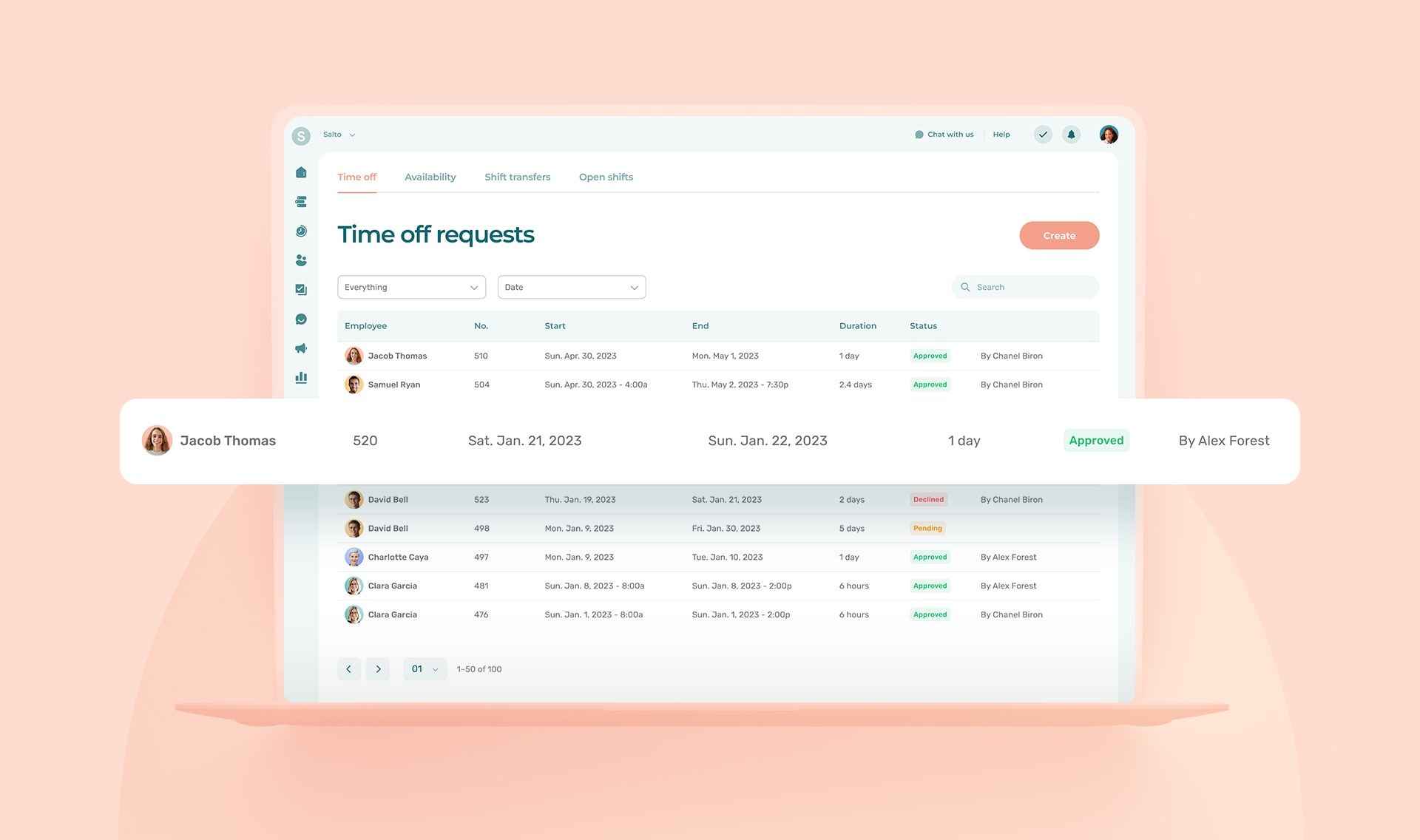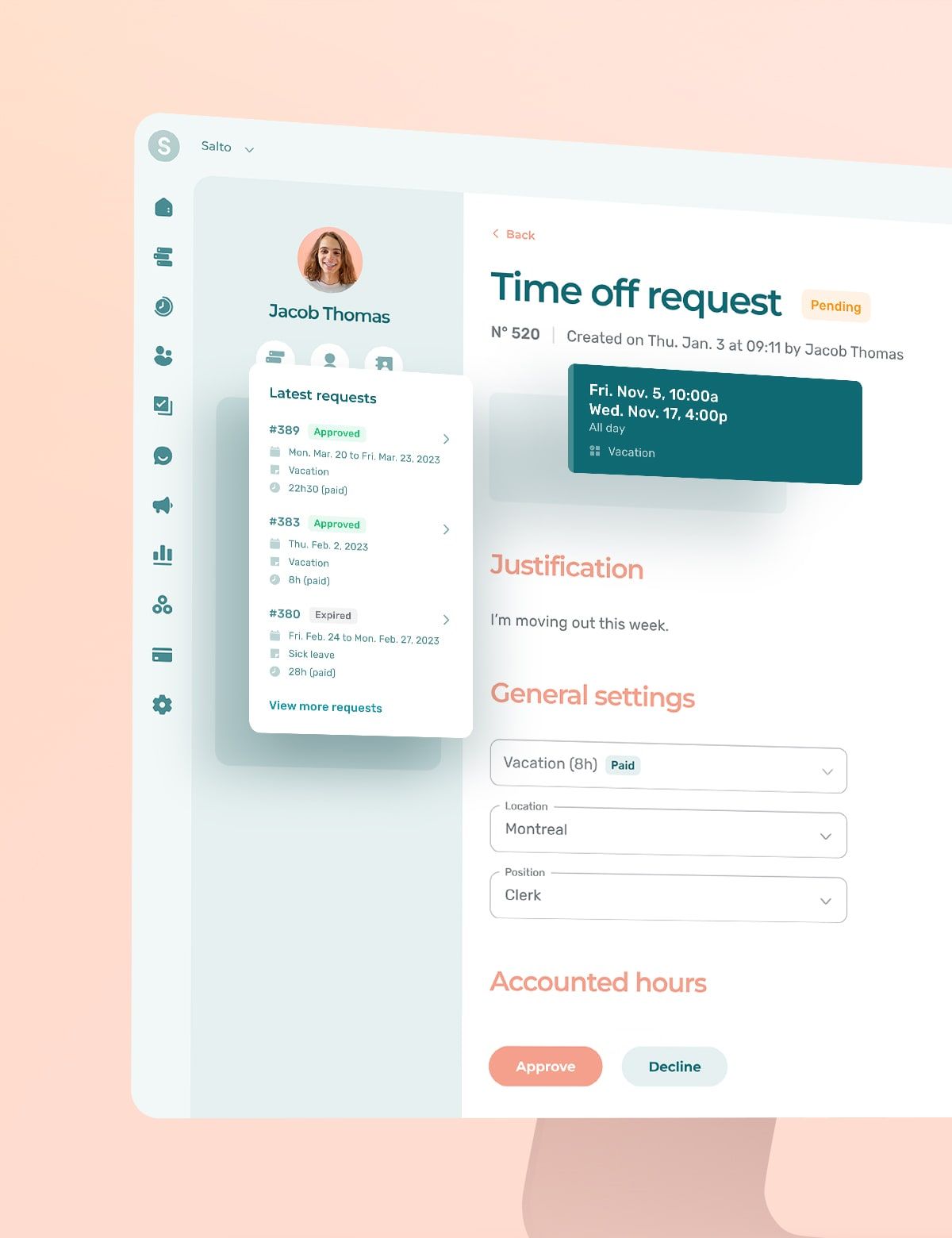Neglecting or brushing aside absence management is a losing proposition for everyone.
When they have to make up for absences, managers and employees quickly lose their motivation and productivity.
The result is that customers also receive poorer service, which directly affects the company’s reputation. In turn, this will harm its overall performance. 🤯
Absenteeism is already a very costly problem for employers—up to 20% of companies’ payroll typically goes to covering the costs associated with unanticipated absences.
Did you know that according to Statistics Canada, Quebecers have the highest workplace absenteeism rates in the country, missing an average 12 days per year? In 2018 in Quebec, absenteeism amounted to 7% of work time, which is consistent with data observed worldwide.
This post:
- Distinguishes between two categories of work absences
- Gives you a comprehensive overview of the benefits of a well-structured approach to managing absenteeism
- Tells you how to set it up
Two Types of Absences, Two Very Different Contexts
Managing time off and absences is fundamental to human resources management. As much as possible, the goal is to prevent the consequences that arise from employee absences. An absence is when an employee doesn’t show up for work when they were scheduled for a shift. There are two types of absences: those that can be foreseen and those that can’t.
1. Foreseeable Absences
Foreseeable absences are normally much less of a problem than spontaneous ones, since they can be planned for. This category includes:
- Vacations
- Paid days off and statutory holidays
- Maternity and paternity leave
- Training days
2. Unforeseeable Absences
Unforeseeable absences have the greatest negative impact on an organization’s managers and employees.
This is especially true for organizations hiring front-line employees, for example in food services, retail, health, etc. This category includes:
- Sick leave
- Bereavement leave
- Time off due to burnout
- Spontaneous leaves of absence for illness or family care
- Dishonest absences (on false pretences)
Why Have a System for Managing Absences?
At a previous job, I remember asking my employer how many days of paid leave I had left, in order to schedule an absence for an appointment. I’ll never forget how stunned I was when he shot the question back to me and said it was up to me to keep track of the days off I had used… This way of managing (or not managing) absences was problematic for several reasons.
So let me explain why as a manager, it is crucial for you to manage your employees’ absences and leaves.
There Are Many Advantages to Managing Absences:
- Allowing your employees to better track their absences
- Curbing the risks of running out of employees during a shift
- Preserving employees’ motivation
- Minimizing the risks of overwhelm and burnout on your team
- Having a real-time overview of your company’s absenteeism rate
- Being able to ask yourself the right questions about the absenteeism rate in X department, for X employee, etc. and being able to draw the right conclusions
Optimize Absence Management With These 4 Helpful Tips
1. Create an Absence-Management Policy
A day off that was requested in advance cannot be treated the same as a shift missed without any notice. In both cases, however, you need a thoughtful, clearly defined procedure in place ahead of time.
Drawing up an absence-management policy will get everyone on the same page and help both you and your team to manage expectations.
“A policy has the advantage of addressing all aspects of absenteeism, whether concerning one-time ‘problematic’ cases or more generalized issues” – Claude Le Corre, CRIA, partner at Le Corre & Associés, a law firm specializing in labor law.
The policy should reflect your corporate culture. For example, if you promote trust in your employees, you may not want to demand a doctor’s note as soon as a member of your team tells you they’re sick.
The Ingredients of a Successful Absence-Management Policy
- Give the responsibility for enforcing the policy to a specific person, perhaps a representative from the HR department or an immediate manager.
- Write up a short and concise policy (2-3 pages at most), as the goal is for it to be read and re-read as needed.
- Make it specific and easy to understand, with as few gray areas as possible.
- Define the number of paid days off per year and the criteria for using them.
For example, at Agendrix, paid time off is called “wellness leave,” so no justification is required. An employee can use any of these leaves for an activity they would like to do, or if they’re sick. - State clear boundaries and provide enough detail to avoid fuzzy situations (“I thought that…”).
For example, if an employee needs to be absent on the same day due to illness or a family commitment, they need to notify their immediate supervisor as soon as possible, by phone. - Provide forms to be filled out, if you have any.
- Distinguish between the process for managing advance leave requests and spontaneous leave requests.
- Distinguish between short leave and long leave.
- Introduce the policy to all your team members and explain how it will be in everyone’s interest: involve them in the process.
2. Choose the Right Tools
Keeping careful track of absences is key to understanding and better preventing excessive absenteeism. But how, in concrete terms, do you manage absenteeism on a team, on an everyday basis?
The first step is definitely to go digital—this will centralize your data while also minimizing the risks of errors and oversights. This is important for employees requesting time off or vacation, but also for tracking one-off absences.
Scheduling Software, a Great Ally
To optimize all these steps, opt for scheduling software that also lets you manage schedules and work hours, as well as employee records and many other aspects of HR management. Scheduling software gives managers and employees an at-a-glance portrait of absences, remaining leave, and time off taken or requested.
In addition to cutting down on back-and-forth communication between employees and managers to ask for time off, digital absence-management systems make it easy to see the extent of any problems around absenteeism.
Using software to manage absences also lets you collect data, which in turn helps analyze absenteeism at your company.
Indeed, only by knowing the extent of the problem can we effectively manage absenteeism.
3. Ask the Right Questions to the Right People
If there’s one thing to keep in mind above all else when it comes to absenteeism, it is the importance of understanding what is at stake. This is why any data you collect must be meticulously analyzed.
Patterns can be detected quickly when you take the time to examine them. If you carefully scrutinize the data, you will immediately see when a colleague is regularly missing Friday afternoons to take care of their grandmother, or Monday mornings because of frequent colds.
A Few Insightful Questions to Help You Go Further
- Has absenteeism climbed since a certain moment/event?
- Are more employees missing work in a given department or team?
- Is it worse at a specific time of the year?
- What grounds have employees have given for these absences?
- Do you provide sufficient downtime (time off and vacation) or are your employees giving themselves that downtime? 😛
- Do you have several medium or long-term absences or are they mostly short, one-off occurrences?
A Difficult Yet Necessary Conversation
Your analysis is bound to be followed by a difficult conversation in which you will have to address the situation together with the employee concerned.
In approaching this delicate task, you must know the limits of your role. For example, what questions are you allowed to ask an employee who is missing work? In what context can you request justification for an absence? And this is where a policy comes in handy.
4. Be Flexible
The three above tips will help you better analyze absenteeism at your organization and manage absences when they occur. The last tip that I would like to offer you is, predictably enough, about how to reduce absences.
Be flexible!
Like a child going behind your back to do something you told them not to do, your employees will go after what they feel they are entitled to if you don’t give it to them yourself.
Your team members need vacation time, leaves, and some wiggle room to stay home when their children have a cold. If possible in your industry, build some flexibility into your scheduling. Otherwise, allow your employees to trade shifts. This openness on your part might save you from having to scramble to find a waitress on a Saturday night or a lab technician in the morning for the 11 a.m. shift. 😉
Absences Speak Volumes About Your Management Methods
Absences are a real problem for many companies, and managers are paying the price. But these absences are first and foremost a reflection of an organization’s health. This is why workplace absenteeism must be carefully managed and analyzed.
An absence-management policy and software to manage leave requests, vacations and absences will be invaluable in helping you meet these challenges. At the end of the day, what matters most is what you choose to do with the information you glean from your absenteeism analysis.












